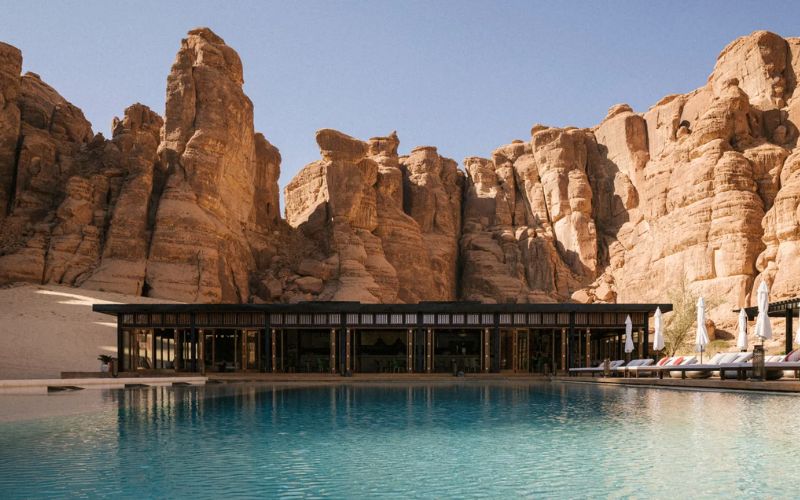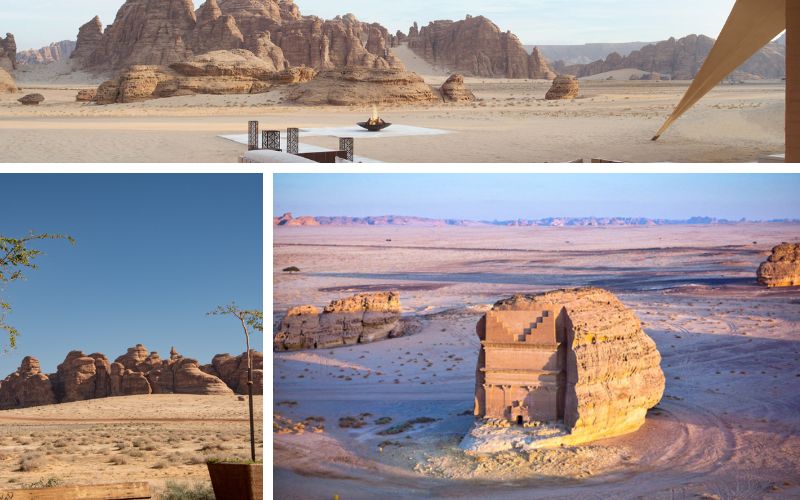
Are you an explorer of historical gems with a keen interest in Arabic cultural heritage? Today will take you on a journey to the Saudi Peninsula, to the ancient city of Al-Ula, where you get to learn about Al-Ula Saudi Arabia Islamic History.
Where is Al-Ula located?
Al-Ula is an ancient city on the north side, 300 km from Madinah, Saudi Arabia. Due to its rich history and archeological site, Hegra, which was designated a UNESCO World Heritage Site, is vital to Saudi Arabia. To preserve the cultural legacy of Al-Ula, the Crown Prince, His Excellency Mohammed Bin Salman, announced a plan named Saudi Vision 2030. With the accomplishment of this plan, the government aims to host 2 million travelers per year. Let’s explore Saudi Arabia’s Islamic history in detail.
History
Al-Ula City was founded in the 6th century BCE, and because of its oasis location to supply water and greenery in the desert, it became a famous route for trading at that time.
In historic times, the area was under Dedan District, but later on, the North Arabian Kingdom of Lihyan rebuilt the city and dominated it for 400 years. Later, the Nabataeans, a long-lost culture that inhabited the area starting around 100 BC and persisted for some 200 years, took over Al-Ula city in 100 BCE.
Since the 19th century, the city has become a central location for Western travelers interested in Al-Ula Saudi Arabia Islamic history.
| Metric | Value |
| Population of Al-‘Ula | 5,426 |
| Area of Al-‘Ula | 2,391 square kilometers (923 sq mi) |
| Number of luxury resorts in Al Ula (2023) | 10 |
| Maximum capacity of Prince Abdul Majeed bin Abdulaziz Airport (2021) | 400,000 passengers per year |
| Number of municipalities in the Governorate of ‘Ula | 4 |
| Number of young Saudis trained for tourism project | 200 |
| Date of establishment of Royal Commission for Al-‘Ula | July 2017 |
| Number of districts planned for Al’Ula by 2030 | 5 |
| Number of tourists targeted by 2030 | 2 million |
| Expected contribution to national GDP by 2030 | SAR 120 billion |
| Size of mirrored façade covering Maraya Concert Hall (2019) | 9,740 square meters (104,800 sq ft) |
| Date of launch of Al-‘Ula vision by Crown Prince Mohammed bin Salman | February 11, 2019 |
| Number of districts in Al’Ula Vision | 1 (Sharaan) |
| Number of Iranian singers at Persian Night in Al-‘Ula (March 6-7, 2020) | 7 |
| Date of Winter at Tantora Festival launch | December 20, 2018 |
| Number of performers at Winter at Tantora Festival (2019) | 6 |
| Size of Elephant Rock (Jabal AlFil) | Not specified |
| Number of activities for tourists in Al Ula | Not specified |
| Number of accommodations in Al’Ula (2023) | 10 |
| Planned future resorts in Al’Ula | Dar Tantora, The Chedi Hegra, Aman Resorts, Sharaan Resort |
| Date of Azimuth Festival (2020) | March 5-7, 2020 |
| Number of performers at Azimuth Festival (2020) | Not specified |
| Date of first European traveler’s description of Al-‘Ula | 1876 |
The Best Time to Visit Al-Ula
October to April is considered the best time to visit Al-Ula City because tourists can enjoy only limited activities due to the sweltering weather in the summer months. Still, in the future, Saudi Arabia will settle in shaded and cooler places so travelers can travel throughout the year.
However, as Saudi Arabia continues to develop its tourism infrastructure, including shaded areas and cooler amenities, the potential for year-round visitation may expand in the future. With ongoing efforts to enhance visitor experiences and mitigate the impact of weather extremes, Al-Ula City aims to welcome travelers throughout the year, ensuring that guests can immerse themselves in its rich heritage and breathtaking landscapes and learn Al-Ula Saudi Arabia Islamic History regardless of the season.
How to get from Dubai to Al-Ula, Saudi Arabia?
Traveling from Dubai to Al-Ula offers various options. Direct flights from Dubai to Al-Ula Airport take approximately 6 hours and 26 minutes but can be costly, with ticket prices ranging from AED 700 to 1700. Driving by car covers a distance of 2151.8 km in approximately 22 hours and 43 minutes, with costs ranging from 850 AED to 1300 AED. Alternatively, budget-friendly bus options are available from Dubai to Dammam and Riyadh, with return tickets priced between AED 200 to 300. From there, travelers can continue by bus to Al-Ula city.
Tourist Spots in Al-Ula City
Al-Ula tourist spots include the ancient city of Madain Saleh, the Elephant Rock, and the Al-Ula Old Town, and the Ashar Valley. Madain Saleh, also known as Al-Hijr, is a UNESCO World Heritage Site and showcases well-preserved Nabatean tombs and rock-cut facades. The Elephant Rock is a natural rock formation that resembles an elephant, making it a popular spot for photography.

Ancient City of Madain Saleh
The ancient city of Madain Saleh, also known as Al-Hijr, is a remarkable archaeological site located in the Al-Ula region of Saudi Arabia. Recognized as a UNESCO World Heritage Site, Madain Saleh holds immense historical significance as the first Nabatean settlement outside of Jordan’s Petra. Dating back to the 1st century BCE, this ancient city served as a crucial trading hub along the incense route, linking the Arabian Peninsula with Mesopotamia, Egypt, and the Mediterranean. Madain Saleh is renowned for its well-preserved tombs and rock-cut facades, showcasing intricate Nabatean architecture and artistry. Visitors to this site can explore the elaborate burial chambers, intricate inscriptions, and stunning rock formations that offer a glimpse into the ancient Nabatean civilization.
The Elephant Rock
The Elephant Rock is one of the most iconic natural landmarks in Al-Ula, drawing tourists and photographers from around the world. This unique rock formation resembles an elephant with its distinctive shape and features, capturing the imagination of all who behold it. Situated amidst the vast desert landscape, the Elephant Rock stands as a testament to the awe-inspiring forces of nature. Visitors can marvel at the sheer size and beauty of this geological wonder, capturing stunning photographs against the backdrop of the desert sky. Whether admiring it from a distance or exploring its surroundings up close, the Elephant Rock offers a memorable and enchanting experience for visitors to Al-Ula and learn more about Al-Ula Saudi Arabia Islamic History.
A Glimpse into Al-Ula Old Town, Saudi Arabia
The Old Town of Al-Ula, the second-largest historic city after Makkah, boasts ancient charm and has been recognized as the best village for tourism by UNWTO. With its maze-like layout comprising 900 mud dwellings, this archaeological site offers a glimpse into the architectural history and lifestyle of its ancient inhabitants. Dating back to the 12th century, the town served as a vital stop for traders and pilgrims traveling from Damascus to Makkah.
Despite its lack of modern amenities, the Old Town of Al-Ula promises to be a captivating destination for history enthusiasts, especially with Saudi Arabia’s ongoing investment in tourism development. Visitors can explore the town’s streets, marvel at its architectural wonders, and peruse the market for souvenirs and traditional Eastern-style clothing. Guided tours, either self-guided with informational signs or led by a local guide (Rawi), offer insight into the town’s rich history. Accessible via a short flight from Dubai Airport to Al-Ula Airport, the Old Town is just a half-hour drive away, beckoning travelers to uncover its ancient treasures.
The Enigmatic Ashar Valley, Al-Ula, Saudi Arabia

The Ashar Valley in Al-Ula is fascinating with its canyons and wind-carved cliffs. The geology of the Ashar Valley spans millions of years. This valley is also home to the most luxurious hotels in Al-Ula, where visitors can enjoy comfortable lodging with dining options cooked by world-class chefs.
The main attraction of Ashar Valley is the Maraya, the largest mirror building in the world. A relationship between nature and human heritage is displayed through the reflections of mirrors. This architectural beauty is a versatile venue for music concerts, exhibitions, and conferences.
The tranquil and vast setting of the valley is perfect for a wellness experience due to the class facilities of the spa in the opulent hotels of the valley, which present a fusion of local and eastern rituals.
Al-Ula Saudi Arabia Resort
Al-Ula boasts top-tier accommodations, including Habitas Al-Ula and Banyan Tree, renowned for their excellent hospitality and amenities. Situated amidst the breathtaking cliffs of Ashar Valley, Habitas Al-Ula offers a unique welcome ritual, Al-Ula Saudi Arabia Islamic History, providing guests with a wooden compass bracelet and observing a two-minute vow of silence for a spiritual experience. The resort features a spa, gym, pool, and captivating art installations.
Similarly, Banyan Tree offers a tranquil retreat amidst stunning rock formations, prioritizing wellness amenities such as spa massages and bath areas under the stars. To make the most of your visit, it’s advisable to plan your trip during the winter months when the weather is pleasant, allowing for participation in various activities like hot air balloon rides, abseiling through magnificent rocks, and desert camping experiences. This period, from October to April, offers ideal conditions to explore the region’s rich culture and art.
How Islam influenced the Dress Codes for Men and Women in Saudi Arabia?
The dress codes for men and women in Saudi Arabia are deeply influenced by a combination of historical, cultural, and Islamic factors. Historically, Saudi Arabia has been influenced by past civilizations that inhabited the region, shaping its cultural norms and traditions. Additionally, the country’s neighbors, all of which are Islamic nations, have contributed to the development of Saudi Arabia’s cultural identity. Countries such as Jordan, Iraq, Kuwait, Yemen, Oman, and the United Arab Emirates share borders with Saudi Arabia, fostering cultural exchanges and influencing dress codes.

Neighbors of Saudi Arabia and their influence on Al-Ula Saudi Arabia Islamic History
In recent years, Saudi Arabia has seen some relaxation in its dress code regulations, particularly for outside visitors. While the abaya remains a customary dress code for Saudi women, it has become optional for foreign visitors. However, visitors are still expected to dress modestly, covering their arms and legs with loose-fitting clothing. This blending of cultural tradition with modernization reflects Saudi Arabia’s evolving approach to dress codes while still respecting Islamic values and cultural norms.
Islamic Influence
Islamic influence plays a central role in shaping the dress codes for men and women in Saudi Arabia. Islamic teachings emphasize modesty and decency in attire, which is reflected in the dress codes enforced in the country. For women, the abaya is a traditional garment worn to adhere to Islamic principles of modesty. Originally a plain black cloak, the abaya has evolved over time to incorporate various colors and patterns while still maintaining its modest design. Alongside the abaya, the hijab and niqab are also commonly worn by Saudi women, further emphasizing modesty by covering the head and face to varying degrees.
Final Thoughts
Sparkle your eyes with Al-Ula Saudi Arabia Islamic History and architectural beauty. This city has a rich and mysterious history, with details dating back 200,000 years and transforming it into a modern and facilitated tourist destination. This archeological site will be a great attraction for history buffs, and tourists can find all the activities that interest them. Adventure seekers can avail themselves of the hiking facility or take a helicopter tour to enjoy a mesmerizing city view. Art lovers can explore the art and heritage monuments, and health-conscious people can enjoy the facilities for yoga and spa massages. To sum up, Al-Ula has something for all types of visitors. Come and experience this remarkable journey before any other of your friends explore its beauty.
Stay tuned for more adventure guides from Salam Travellers.



